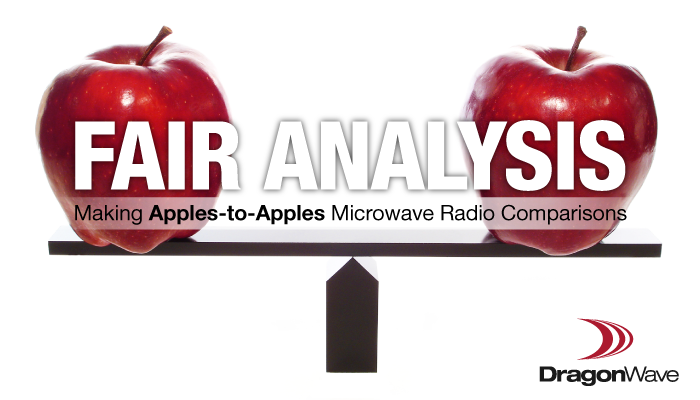Fair Analysis: Making Apples-to-Apples Microwave Radio Comparisons

Within any industry, there exists a group that strongly believes electronic products are simply commodities. These customers want the best product for the best price that, in turn, delivers a highly reliable network. What most customers don’t realize is how to conduct an apples-to-apples product comparison on point-to-point microwave equipment.
The simple conclusion is compare system gain of the microwave products being considered, particularly if you do not have the time or engineering faculties to understand more detailed information, Since the radio specifications are the only factors that don’t vary in any analysis, exploring these is an ideal way to compare different vendors, as it removes any variables.
System gain of a radio (TX power – Rx Threshold) defines the radios performance expectations. It is important to obtain these from the MW vendors radio files and then to validate via product bench testing or if publically available, the regulators licensing database.
A more detailed explanation is as follows:
Microwave planning tools are used to calculate link availabilities using a radio’s specification files. Different factors that can contribute to link availability include the radio’s specs, environmental factors and reliability.
When different users do analysis, one radio can show a better link availability than the other. This result could be misleading because there are many variable factors that affect the link availability. These include the environmental factor settings and the reliability method used. One environmental factor that has an impact is the multipath and rain availability, as each region has a different susceptibility to these. So comparison of radios should be done where a business plans to deploy the links. There are two types of reliability methods to choose from for calculating the multipath availability–ITU or Vigants-Barnett—with one giving a better result than the other depending on the region. Also, various radio specs are released at different stages of development, so analysis does not always mention which specs are being used.
When comparisons are made, different users use different settings to calculate the link availability based on their preference. This gives an inconsistent way to compare different radios. The only way to have a fair comparison would be to use the same settings—something that is not always done.
Other detailed factors which impact link availability and vary on user settings/preference:
- Planning tool used
- Rain — multiple rain databases available which calculate the rain availability (examples are: Crane, ITU-R P.530, ITU rain algorithm)
- Region where analysis is conducted — lower frequencies are more prone to multipath and higher frequencies are more prone to rain
- Elevation for end points (Path Inclination) — the higher the elevation difference between end points, the better the link availability
- Center Frequency — which frequency is entered from the range of frequencies of a diplexer
- Antenna manufacturer used — each manufacturer can have a slightly different gain for the same antenna size
- Reliability Method — ITU (even within the ITU methods there are multiple algorithms to choose from; Rec ITU-R P.530-6, Rec ITU-R P.530-7/8, Rec ITU-R P.530-9/12 and Rec ITU-R P.530-13) or Vigants-Barnett; one reliability method can give a more optimistic result than the other (dependent on path)
- Antenna gain used — top band, mid band or low Band gain can be used
- Fade Margin target — at times the fade margin target is overlooked, with focus only on availability
- Field Margin — added to compensate for installation and product variations from lab test (typically add 1dB)
- Capacity target — average packet sizes show average throughput to expect on a link; larger capacities can also be shown assuming large frame sizes
- Modulation target — better RX threshold for lower capacity or higher capacity for slightly worse threshold
- Adaptive Code Modulation — hitless or not (will affect RX threshold and TX power). RX threshold varies for the same modulation if it is stand-alone (better) or in ACM mode (worse). Multiple radio files are created for each mode.
- Product setup — single ODU vs dual ODU needed for capacity target. Any extra accessories such as an externally mounted coupler needed (If so, coupler loss will be added.)
- Antenna to Radio mount — is radio mounted directly to antenna or through waveguide (If so, what waveguide loss to consider.)
The radio specifications are the only factors that remain constant between different analysis (assuming same specs are used; i.e. Marketing/Data Sheet values (Typical) or measured/ guaranteed numbers)
The specifications define how a radio will behave; the relevance of some of the radio specifications are defined below.
Radio factors which impact link availability and do not vary between users:
- TX Power
- Equivalent Isotropically Radiated Power (EIRP) – Power Radiated from antenna; TX power plus antenna gain
- RSL – higher TX power will give a better RSL
- RX Threshold
- Lower the RX threshold – the more tolerant the link, it will be available till RX Threshold is reached
- Fade Margin – How much fade a link can go through will depend on its fade margin (RSL – RX Threshold)
- Saturation level — the higher the saturation level, the shorter the links can be
Since the radio specs are the only factors that don’t vary in an analysis, it is the ideal way to compare different vendors, as it removes any variables.
System gain of a radio (TX power – Rx Threshold) defines the radios performance expectations.
Example of DragonWave’s Harmony EnhancedMC
|
Radio Model |
11EM80HFC626v05haam |
|
Frequency |
11Ghz |
|
Channel Size |
80Mhz |
|
Modulation |
2048QAM |
|
TX Power |
29dbm |
|
RX Threshold |
-51.9dbm |
|
System Gain |
80.9dBm |
